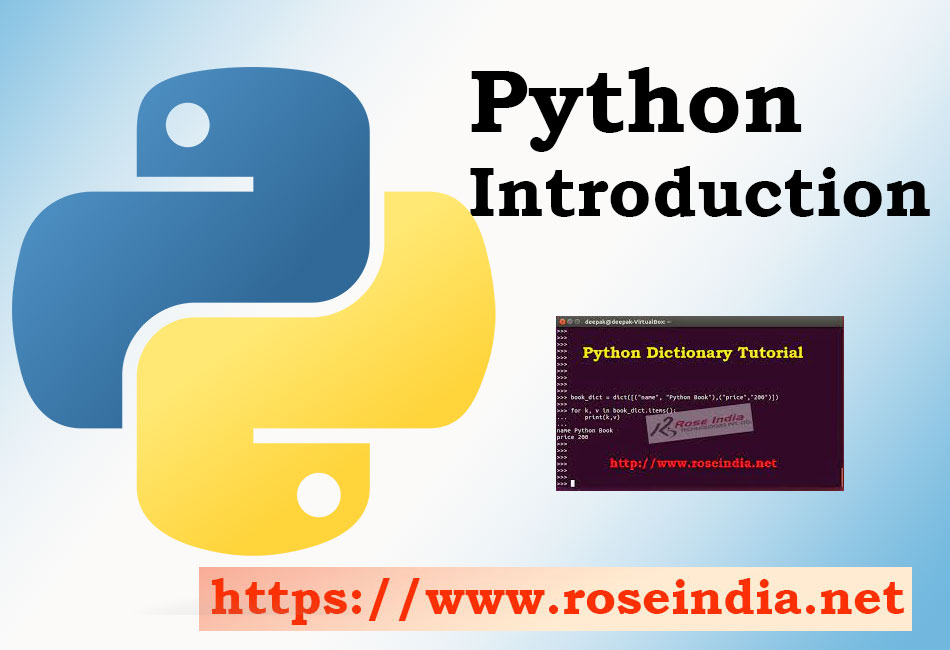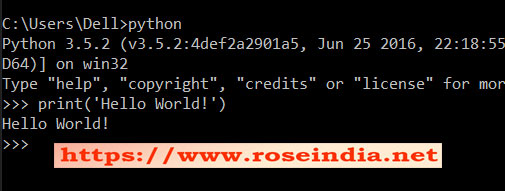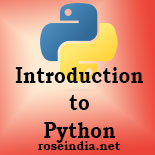Python programming Language - An Introduction
Python is a procedural programming language with the support for object-oriented programming. This short guide will help you to understand Python 3 and see how it can be used in the projects. Python is used for developing programs of various types to meet business requirements. Python is an easy to learn procedural programming language which is being used by developers around the world. In this we are going to introduce this language in very detail.
Introduction to Python In this tutorial we are Introducing you with the Python Programming Language, Python is a general purpose, high-level programming language. This will introduce the Python Programming Language and explain how you can learn it.
This guide will introduce you with the Python programming language and also show you how to create your first Hello World program. This post will give you a brief idea about the Python programming language. After going through this post you should be able to chalk out your plan for learning Python from the beginning. The important topics you should learn in Python is Variables, Statements and Expressions. You should also learn Python Dictionary as it is one of the most used data structure in Python.
The job prospects for the Python developers are increasing fast as many companies are using Python for development of their new applications. Many companies are also migrating their applications to cloud environments. Python is also used for developing applications for cloud computing environments.

Let's understand the Python programming language and see what could be the best learning plan.
What is Python?
As said object, Python is a procedural programming language which executes codes one line at a time. Python was originally developed by Guido van Rossum, a Dutch programmer and it was released in 1991. Now this is one of the most popular programming languages.
Guido van Rossum started their work on Python programming language late in 1980s as a successor to the ABC programming language. Python's first version was released in 1991 as Python 0.9.0. In the year 2000, Python version 2.0 was released with many features including cycle-detecting garbage collection, reference counting, and Unicode support.
Later in 2008, Python version 3.0 was released and this version is not completely backward-compatible with earlier versions. These days Python 3.x is being used by the developers for developing their applications. Python 2 is no more in development or in support. Python 2 was discontinued in 2020 and its last version was 2.7.180. Python popularity is increasing consistently and its ranking as one of the most popular programming languages.
Technically Python is a high-level programming language which is used as a general-purpose language for developing applications. Python uses indentation while the code block makes it more readable. Python was designed and developed emphasising code readability with use of significant indentation during coding. For the beginners Python code indentation could be confusing especially if you are coming from the Java background. But in a few days you will find code indentation much easier.
Python programming language is a dynamically-typed language with automatic memory management and garbage collection. Python is a very feature rich programming language which supports multiple programming paradigms. It supports structured (particularly procedural), object-oriented and functional programming features.
The basic purpose of Python is to provide programmers with a simple and consistent language to develop software of many different use cases. Python is a general purpose, high-level programming language, whereas C/C++ is a high-level language focused on applications and APIs. Python is very easy to learn and Python offers a broad range of tools including many IDE tools for software development.
Python is designed to be easy to read, easy to write, and easy to understand. Python is often described as a dynamic, multi-paradigm, high-level programming language with a strong emphasis on extensible, re-usable and clear code.
- Python is an interpreted programming language
- Unlike C-style languages, Python is compiled in runtime. Because Python is compiled at runtime, dynamic typing is not available in Python
- Python programmers prefer to write python code to be readable and simple, regardless of the program's type.
How can Python be used?
Python comes with many libraries which can be used to develop applications of many different businesses. Python can be used to develop:
- Web applications - There are many libraries
in Python which helps in the development of web
applications(server-side)
- Software Development - Python can be used
to develop softwares for various business data processing.
- Mathematics - It can be used in mathematics
for solving mathematical problems.
- System Scripting - Python can be used to develop scripting programs that can be executed from cron job or from the command line terminals
So, Python is very popular among developers for development of different types of applications. Data Scientists and Data Analytics engineers are using Python for developing AI/ML models.
Why Python programming?
Why should you use Python as a programming language? Python is an easy to learn programming language, that's why programmers are learning it fast and jumping on the project. Python is a mature programming language and comes with a large number of libraries to create applications. Python is highly modular and new modules can be developed easily, which can be further used in future projects.
Python is supported by the world's top companies including Facebook, Amazon Web Services, and especially Google. New enhancements, bug fixes and updates are coming with the Python programming language. This language is one of most active software projects with consistent increase in popularity.
Python programming language is a faster interpreted language and in the recent release of Python 3.11, many changes have been made to make it up-to 60% faster as compared to Python 3.10. Developers should migrate their applications to Python 3.11 to take this advantage.
Python comes with the libraries for development of applications for machine learning, artificial intelligence and cloud computing. It comes with excellent job orchestrators such as Airflow for running enterprise jobs. There are many libraries for data visualisation that can be used by the Data Scientists and developers for visualisation of their data.
Learning Python programming language
For learning Python from scratch you have to download and install python on your development computer. In the beginning you can learn syntax, data types, data structures, and programming idioms.
Python is an object-oriented programming language, yet comes with easy syntax and can be learned quickly. Classes represent real objects in your program, and objects represent data. Every object has a reference to another object (its parent). Objects and classes describe all the data needed to build a program (data structures) and the rules for using that data.
The most important data structure in Python is a list and the list is the fundamental element in many other data structures. If you are into data structures in Python, you already know what a list is.
A Python list is a sequence of values, usually strings or integers. A list, on the other hand, is an ordered collection of elements, where when one element is incremented another is removed or added at exactly the same position.
A Python list is not a variable type in Python's basic syntax, although lists are an object type in Python:
x = [1, 2, 3]
In the above example we are simply creating a list of integer elements.
Python Hello World - First Python Example
Now we will learn to make our first Python program that simply prints ?Hello World!? on the console. To run this program you have to first install Python on your computer. You can check details at: How to install Anaconda Python in Windows 10?
After the installation open the terminal and type python to open the Python terminal as show below:

In the terminal type following code: 0
print('Hello World!')
Above code will print ?Hello World!? in the terminal.
In this section we introduced the Python programming language. Python is the fastest growing programming language and developers should learn it.
Check more tutorials at: Python tutorials section. 1
